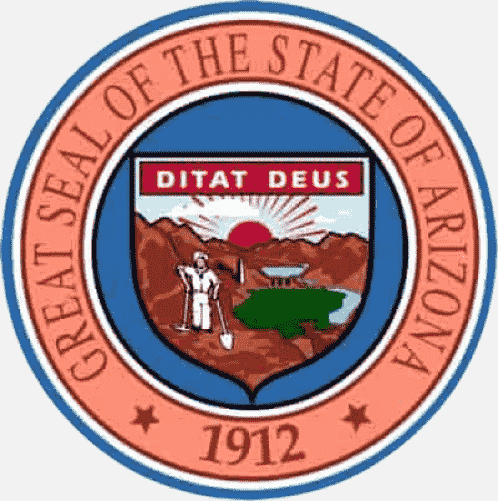 State Flag |  State Seal |
Arizona is a state in the southwestern region of the United States. It is also part of the Western United States and of the Mountain West states. It is the sixth largest and the 15th most populous of the 50 states.
- ABBREVIATION: AZ
- NICKNAME: The Grand Canyon State
- POPULATION: 7,582,384 (2024 est.)
- CAPITAL: Phoenix
- STATE BIRD: Cactus Wren
- STATE FLOWER: Saguaro Cactus Blossom
- AREA: 113,990 sq. mi.
- TIME ZONE: Most of state Mountain: UTC -7 (no DST) – Navajo Nation Mountain: UTC -7/-6
- ENTERED UNION: Feb. 14, 1912
- ALTITUDE: High 12,637 ft. Humphreys Peak
- CLIMATE: Clear air, nearly constant sunshine, low humidity, low rainfall. Hot summers, winters generally mild.
In 1858 Congress noted: “The region is all together valueless”, “after entering Arizona there is nothing left to do but leave”. Of course nobody thinks of Arizona that way today, it’s a well appreciated region of the United States that attracts millions of tourist every year.
An arid yet beautiful land of plunging gorges like The Grand Canyon, varicolored deserts, erosion-carved buttes, mountains and parched yellow sands nurturing only such desert life as Gila monsters and Saguaro Cactus, Arizona is, paradoxically, one of the fastest growing areas of the nation.
In addition to the huge mining and cotton industries, the endless sunshine and open spaces have lured thousands of small and large manufactures to the urban areas in the last 50 years, nourishing a highly productive industrial boom.

The Grand Canyon, Arizona
Due to its numerous golf courses, Arizona is home to several stops on the PGA Tour, most notably the Phoenix Open, held at the TPC of Scottsdale, and the WGC-Accenture Match Play Championship at the Ritz-Carlton Golf Club in Marana.
FUN FACTS:
- London Bridge, which once spanned England’s River Thames, was purchased for Lake Havasu City in the 1960’s. The bridge was shipped across the Atlantic and reconstructed in the Arizona desert.
- Lake Powell, the nation’s second largest reservoir, is named for John Wesley Powell, the one-armed Civil War veteran who was the first white person to successfully navigate and map the Grand Canyon.
- The federal government owns 88 percent of Arizona’s land, including 21 Indian reservations. Of these, the Navajo Nation Reservation is the largest.
- Pluto, once classified as a planet, was discovered from the Lowell Observatory in Flagstaff in 1930.
- Arizona’s largest lizard, the Gila monster, is the only poisonous lizard in the United States.
- The amount of copper on the roof of the Capitol building is equivalent to 4,800,000 pennies.
History:
Arizona’s history is one of ancient civilizations, cultural crossroads, territorial conflict, and striking transformation. Long before becoming the 48th state of the United States, Arizona was home to some of North America’s earliest and most sophisticated Native American cultures.
The Ancestral Puebloans (also known as the Anasazi), Hohokam, and Mogollon peoples built complex societies in the desert, creating irrigation systems, cliff dwellings, and vibrant trade networks. Remnants of these early cultures can still be seen at sites like Montezuma Castle and Canyon de Chelly.
By the time Europeans arrived in the 1500s, several Native tribes, including the Apache, Hopi, Navajo, and Tohono O’odham, were well established in the region. In 1540, Spanish explorer Francisco Vázquez de Coronado led an expedition through Arizona in search of the legendary Seven Cities of Gold.
While he never found the riches he sought, Spanish missionaries and settlers followed, establishing missions and introducing Christianity and European customs to the Indigenous peoples.
For more than two centuries, Arizona was part of New Spain and later Mexico after its independence in 1821. In 1848, following the Mexican-American War, the United States gained most of Arizona through the Treaty of Guadalupe Hidalgo. The southern portion was added in 1854 with the Gadsden Purchase, which completed the present-day borders of the state.
Arizona was officially organized as a U.S. territory in 1863. During this period, settlers began moving in, drawn by mining opportunities and land prospects. Conflict often erupted between newcomers and Native tribes, particularly the Apache, who resisted encroachment. Legendary Apache leader Geronimo fought against U.S. and Mexican forces for decades before his surrender in 1886 marked the end of the Indian Wars in the Southwest.
The late 19th and early 20th centuries saw rapid development, fueled by mining—especially for copper, silver, and gold—and the arrival of the railroad. Agriculture also grew with the expansion of irrigation systems that made the arid land productive. As towns and cities developed, Arizona’s population increased, and on February 14, 1912, it became the 48th state—the last of the contiguous states to join the Union.
In the 20th century, Arizona continued to evolve. Its warm, dry climate made it a hub for health resorts and retirement communities, while its dramatic desert landscapes and national parks—such as the Grand Canyon—fueled a booming tourism industry. During and after World War II, military bases and aerospace industries expanded, bringing new jobs and population growth.
Arizona has also been central to Native American history and rights, with 22 federally recognized tribes today and large reservations like the Navajo Nation. Though complex challenges remain, Native communities continue to play a vital role in the state’s identity.
Today, Arizona is a vibrant mix of cultures, history, and innovation. From its Indigenous roots and Spanish colonial past to its role in modern politics and technology, Arizona’s story reflects the resilience and diversity of the American Southwest.